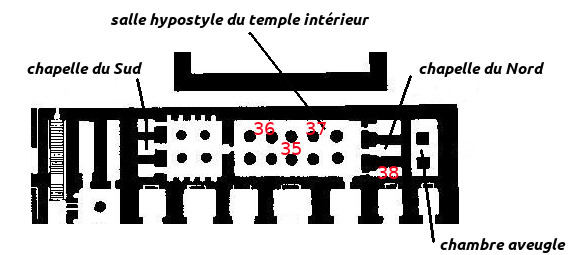This This cow-headed deity (sometimes depicted as a woman with cow's ears) protected women and the dead, as she was likened to the Goddess of the Kingdom of the Dea; she was also goddess of music.
This cow-headed deity (sometimes depicted as a woman with cow's ears) protected women and the dead, as she was likened to the Goddess of the Kingdom of the Dea; she was also goddess of music.
The dead (Occident): The Land of the Setting Sun: this is the Kingdom of the Dead (the souls of the dead go to the Land of the Setting Sun).
and Lord of Abdjou. From the time of the 11th Dynasty, the nome [glossary]
Nome : A word of Greek origin, designating administrative provinces (depending on the period, there were between 38 and 42).
and its capital acquired considerable importance benefiting from the growing support which the pharaohs accorded to the Osirian myths [glossary]
 Isis' husband; after having been killed by his brother, Seth, he fathered a son, Horus, who, grown to adulthood, avenged him. He is represented with his crown, Atef, his scepter, bequa and his flail, nekhekh.
Isis' husband; after having been killed by his brother, Seth, he fathered a son, Horus, who, grown to adulthood, avenged him. He is represented with his crown, Atef, his scepter, bequa and his flail, nekhekh.
: if the exegetes are to be believed, the god's head was purportedly taken to Abydos, after his brother, Seth, assassinated and dismembered him. On the occasion of the great annual and biennial feasts, crowds of pilgrims from all the Kingdom's nomes converged on the area around the great temple and, together, celebrated the divine mysteries, Osiris' and Seth's confrontation, the god's death at his own brother's hands, his dismemberment, Isis' pain and anger, her search for her husband's scattered pieces, the funeral and, finally, the resurrection of the Justified One, who took back his place at the head of his people and his domains. Some episodes of this Passion Play took place in the open with the active and, no doubt, rowdy participation of the hordes of pilgrims. Others, more secret or more arcane, took place inside the temple with the priests and servants as the only players. Before starting home for their provinces at the conclusion of what had come to be known as the Festival of Osiris as dynasty followed dynasty, the pilgrims instituted the custom of offering a token of their faith to the god, a humble votive offering of dried alluvium, statuettes stelae, chapels or, if they were kings, entire temples. Abydos was at the peak of its glory during the 19th Dynasty: it was then that the great Seti I went on a pilgrimage there and also dedicated his gift, the King Menmaatre's August Castle for Millions of Years [glossary]
Castles for millions of years On Thebes' west bank, the Pharaohs of the 18th, 19th and 20th Dynasties had large religious monuments built, which were improperly called "funerary temples". In reality, they used them, during their liftime, to worship the deified pharaoh associated with Amon, the main Theban deity. The ancient Egyptians rightly preferred the term "Castles for millions of years".
to Osiris; this is one of the most perfect of the holy sites, but also one of the most disconcerting in Egypt.
Initiatic journey to discover Abydos: The pilgrim must go through successive stages. During your exploration, you must follow the stages 1 to 8 in the correct order.

This
In the beginning of what is known as the Predynastic period (3300 - 2920 B.C.), the population had gathered in two centers: one in the North, in the Delta region and the other in the South, in Hierakonopolis, where we know of sovereigns such as King Scorpion and Narmer. The last King of the Predynastic period, he conquered Lower Egypt and unified the country, no doubt after several wars. His successor, Aha - who can probably be identified with the legendary Menes - founded the 1st Dynasty (from the Greek: dynam(is) = power). The two first Dynasties were called Thinite because, according to the Greek historian, Manethon - to whom we owe a list of all thirty lineages of the Egyptian sovereigns - the pharaohs of this period came from the city of This, of which no trace was ever found, but which must have been located in the Abydos area.This
was renamed Abdjo, which the Greeks transcribed as Abydos. Leaving ThebesThebes
During the 18th Dynasty (ca. 1550 - 1295 B.C.), the city of Weset was founded by Amenhotep I; better known by its Greek name, Thebes, it became the heart of the country. It was at this time that the Great Temple of Amon in Karnak became the country's most important religious center and the royal necropolises were excavated in he Valley of the Kings and the Valley of the Queens.Thebes
to go down the Nile, passing Dendera
Dendera
Dendera was the capital of the sixth nome of Upper Egypt, and its necropolis contains tombs dug betweenthe Predynastic period and the end of the Old Kingdom. This site's renown is due to the famous Temple of Hathor, which dates back to the Greco-Roman period. Dendera was dedicated to Hathor, one of the oldest Egyptian deities, represented as a cow or a woman with cow's ears.Dendera
where HathorHathor
 This cow-headed deity (sometimes depicted as a woman with cow's ears) protected women and the dead, as she was likened to the Goddess of the Kingdom of the Dea; she was also goddess of music.
This cow-headed deity (sometimes depicted as a woman with cow's ears) protected women and the dead, as she was likened to the Goddess of the Kingdom of the Dea; she was also goddess of music.
Hathor
reigned, the traveler soon comes to al-Balyana, from where he can go overland to Arabat-el-Madfouneh, the barren hamlet which guards the entrance to the antique site of Abydos.
At the edge of the desert, he will discover the ruins of the holy city:- Seti I's votive temple dedicated to OsirisOsiris
 Isis' husband; after having been killed by his brother, Seth, he fathered a son, Horus, who, grown to adulthood, avenged him. He is represented with his crown, Atef, his scepter, bequa and his flail, nekhekh.OsirisSeti I'sMenmaatre Seti I (1312-1298 B.C.) is among the greatest figures of the royal history of the Double-Country. The son of Ramesses I, founder of the 19th Dynasty, he was Ramesses II's father and the first of this line of absolutist pharaohs who succeeded each other on the throne until the extinction of the 20th Dynasty, when Ramesses XI who, unable to live up to the heavy legacy, died miserably in 1085 B.C.
Isis' husband; after having been killed by his brother, Seth, he fathered a son, Horus, who, grown to adulthood, avenged him. He is represented with his crown, Atef, his scepter, bequa and his flail, nekhekh.OsirisSeti I'sMenmaatre Seti I (1312-1298 B.C.) is among the greatest figures of the royal history of the Double-Country. The son of Ramesses I, founder of the 19th Dynasty, he was Ramesses II's father and the first of this line of absolutist pharaohs who succeeded each other on the throne until the extinction of the 20th Dynasty, when Ramesses XI who, unable to live up to the heavy legacy, died miserably in 1085 B.C.
In fact, Seti I was not born to power; Horemheb, the last of the 18th Dynasty was childless and seems to have singled him out from others because of his intelligence and determination; worried, however, about imposing too brilliant a candidate on Egypt and the others, whom they certainly would have blocked, he had the subtlety to name Seti's father, Ramesses, a career general from Tanis, then old and well past his prime. The high clergy and the court approved of this choice, certain that they would be able to control a pharaoh without ambition or motivation. When he died two years later and was succeeded by his son, Seti, they finally came to realize that Horemheb had given them their master.
Never fruitlessly considering reconquering the huge Asian empire which Pharaoh Thutmosis II had carved out two centuries earlier, and thus implicitly admitting that his immediate predecessors' negligence, notably that of Akhenaten, had irremediably destroyed Egypt's chances in Asia Minor and left the Hittites as masters of the field, Seti limited his actions to clean-up campaigns within the borders of the kingdoms which had remained loyal to his cause. In so doing, he implacably defeated the revolting Bedouins in southern Palestine, quelled a coalition of Canaanite princes, mysteriously supported by the Hittites and re-established his authority as far north as Tyre.
Inside his kingdom, Seti proved to be a wise and moderate administrator, a pharaoh with clear goals, who knew how to make people forget the errors of the preceding reigns; Egypt soon forgot that it had narrowly escaped civil war.
Concerned about restoring the royal image to its former glory, Seti was also a great builder; he knew that stone had a longer memory than man. He was responsible for some of the most dazzling achievements in all of Egyptian history, notably the hypostyle hall of the Great Temple of Amon in Karnak, which has remained unchallenged down through the ages. A number of sanctuaries in Middle and Upper Egypt bear his cartouche, proof that he was dedicated to their restoration, enlargement and embellishment. Finally reflecting on his own eternal destiny, he ordered the largest underground tomb ever seen and erected a funerary temple at a site called Gournah, between the fertile lands and the desert; it was, no doubt, a reflection of his own majestic image; unfortunately, ill-used by time and man, pillaged by those who used its blocks to their own ends, it is now nothing more than a hypostyle hall, a vestibule and an open pronaos in the Western desert. As if to gain a foothold in Osiris' kingdom, Seti added his Abydosian foundations to his tomb and his temple.Seti I's - an Osireion, designed as the god's own tomb
- a second temple bearing Ramesses II's cartoucheCartoucheA loop of cord with a knot at its base, in the side of which the Pharaoh's name was written. The cartouche, the symbol of the Sun God's universal power - and thus the Pharaoh's - was reserved for the Pharaoh's nomen and pronomen.Cartouche.
- further on, monument foundations dating from the Old, Middle and New Kingdoms, sanctuaries and tombs.
Abydos
In the beginning of the third millennium B.C., Abydos was the domain of the pharaohs of the first two dynasties; the city was then called This. Later, probably at the beginning of the Old Kingdom when Djeser made Memphis his capital, This was renamed Abdjou, which the Greeks transcribed as Abydos.
Originally, the god Khentamenti was worshiped there; but during the 11th Dynasty, for reasons which are thought to be more political than religious, Pharaoh Antef imposed the worship of Osiris, who became Osiris-Khentamenti, Osiris, Leader of the Dead [glossary]
The dead (Occident): The Land of the Setting Sun: this is the Kingdom of the Dead (the souls of the dead go to the Land of the Setting Sun).
and Lord of Abdjou. From the time of the 11th Dynasty, the nome [glossary]
Nome : A word of Greek origin, designating administrative provinces (depending on the period, there were between 38 and 42).
and its capital acquired considerable importance benefiting from the growing support which the pharaohs accorded to the Osirian myths [glossary]
 Isis' husband; after having been killed by his brother, Seth, he fathered a son, Horus, who, grown to adulthood, avenged him. He is represented with his crown, Atef, his scepter, bequa and his flail, nekhekh.
Isis' husband; after having been killed by his brother, Seth, he fathered a son, Horus, who, grown to adulthood, avenged him. He is represented with his crown, Atef, his scepter, bequa and his flail, nekhekh.
: if the exegetes are to be believed, the god's head was purportedly taken to Abydos, after his brother, Seth, assassinated and dismembered him. On the occasion of the great annual and biennial feasts, crowds of pilgrims from all the Kingdom's nomes converged on the area around the great temple and, together, celebrated the divine mysteries, Osiris' and Seth's confrontation, the god's death at his own brother's hands, his dismemberment, Isis' pain and anger, her search for her husband's scattered pieces, the funeral and, finally, the resurrection of the Justified One, who took back his place at the head of his people and his domains. Some episodes of this Passion Play took place in the open with the active and, no doubt, rowdy participation of the hordes of pilgrims. Others, more secret or more arcane, took place inside the temple with the priests and servants as the only players. Before starting home for their provinces at the conclusion of what had come to be known as the Festival of Osiris as dynasty followed dynasty, the pilgrims instituted the custom of offering a token of their faith to the god, a humble votive offering of dried alluvium, statuettes stelae, chapels or, if they were kings, entire temples. Abydos was at the peak of its glory during the 19th Dynasty: it was then that the great Seti I went on a pilgrimage there and also dedicated his gift, the King Menmaatre's August Castle for Millions of Years [glossary]
Castles for millions of years On Thebes' west bank, the Pharaohs of the 18th, 19th and 20th Dynasties had large religious monuments built, which were improperly called "funerary temples". In reality, they used them, during their liftime, to worship the deified pharaoh associated with Amon, the main Theban deity. The ancient Egyptians rightly preferred the term "Castles for millions of years".
to Osiris; this is one of the most perfect of the holy sites, but also one of the most disconcerting in Egypt.
Abydos
pioneers, researchers and travelers
For more than a century, the greatest names in Egyptology found their renown in Abydos and competed to restore its original splendor.
- By the middle of the eighteenth century Claude-Étienne Savary had been to Abydos: "After walking west for an hour, one comes upon the remains of Abydos, where Ozymandius built a magnificent temple in honor of Osiris, it was the only one in Egypt where dancers and musicians were prohibited from entering. This city, reduced to a simple village under Augustus' empire, is now only piles of uninhabited rubble. But, to the West of these ruins, Ozymandius' famous monument can still be seen. One first enters under an approximately sixty-foot-high portico, supported by two rows of thick columns. The immovable solidity of the edifice, the huge masses which make it up and the hieroglyphics which cover it make one appreciate the work of the Ancient Egyptians."
- The scientists of the Egyptian Expedition carried out the first cursory study of the layouts of the most accessible ruins. Edme Jommard reports in Volume IV of the Collection of Observations and Research of the Egyptian Expedition: "The interior of the building is perfectly preserved. The sculptures and the colors which covered them were nearly intact, and one had to admire the lively brightness of the blue and other hues which had been used in the paintings, as though they had just been finished. (...) The decoration, remarkable for the richness of its colors, is very simple in contrast to the architecture. There is little variety to be found in the columns, capitals and comices. Elsewhere, there is a great diversity of proportion, of character and of absolute size of these different architectural elements, which more or less harmoniously balances and contrasts them in the various rooms of the edifice, yet without ever violating the rules of symmetry. Here, symmetry rules supreme, and it would seem that the architecture was deliberately meant to be ornamentally sober, in order to make the sculptures, the reliefs or the frescos which cover the walls and ceilings, stand out."
- Some thirty years later, Champollion passed al-Balyana but didn't stop; the Swiss, Charles Gleyre, did the same at approximately the same period; he was an important sketch artist and chronicler, whose pencil sketches and aquarelles are preserved in the Musée Cantonal des Beaux-Arts in Lausanne. Thebes' proximity seems to have made them both take shortcuts.
- The first scientific excavations were directed by Mariette between 1860 and 1863.Thanks to the French government's financial support, they were published as the Excavations done in Egypt, Nubia and the Sudan, by order of the Viceroy, with, as asubtitle, First Series - Gebel Barkal, Abydos. Mariette and his two assistants wrotethe text, and the plates were done by the engraver, Devria. Two additional volumes appeared in 1869 and 1880. Fifteen years later, Amlineau replaced Mariette in the field and directed his efforts to the western zone of the site, in the locations known as Umm al-Qa'ab; it was then that the large Thinite necropolis was unearthed.
- The English expeditions, led by Sir Flinders Petrie, took the place of the French in the beginning of the twentieth century. At the bottom of a well to the north of Seti I's votive temple and near the remains of a sanctuary which seems to date back to the Old Kingdom, Petrie found several invaluable statuettes, one of which, in ivory, represented an unknown Thinite sovereign, wearing the Crown of Upper Egypt. A statue of Pharaoh Khufu, also in ivory, seven centimenters high, was even more valuable and is, as far as is presently known, the only effigy of the greatest builder in Egyptian history.
- After Petrie, Ayrton, Curelly and Weigall excavated other isolated foundations, amongst which were the cenotaphs of Senwosret III and Ahmosis. The Osireion was identified and uncovered by Ms. M. Murray and excavated from 1912 to 1914 by the Egypt Exploration Society, then operated by Naville. Various campaigns to restore Seti l's votive temple and its immediate surroundings went on until 1954.
pioneers, researchers and travelers
Initiatic journey to discover Abydos: The pilgrim must go through successive stages. During your exploration, you must follow the stages 1 to 8 in the correct order.
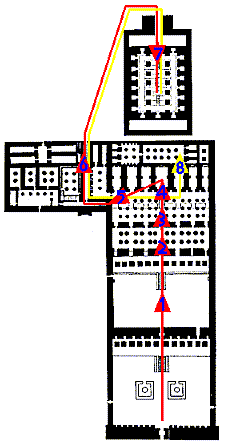
 A small chapel of stone or wood inside the sanctuary, in which the god's effigy was kept.
A small chapel of stone or wood inside the sanctuary, in which the god's effigy was kept. A monumental temple entrance, consisting of a portal between two enormous trapezoidal monoliths.
A monumental temple entrance, consisting of a portal between two enormous trapezoidal monoliths.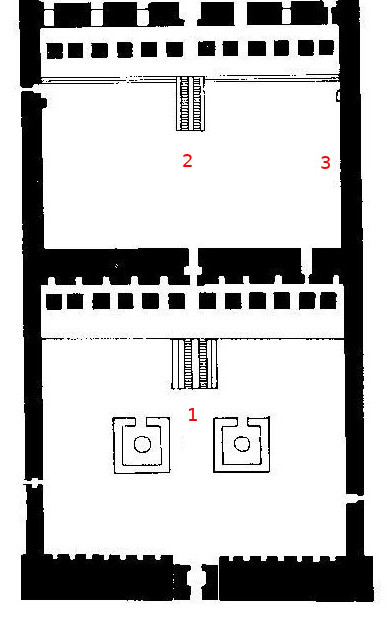
 Divine personification of the cosmic order, secondarily connected to the concepts of truth and justice. She wears an ostrich plume on her head, the transcription of her name.
Divine personification of the cosmic order, secondarily connected to the concepts of truth and justice. She wears an ostrich plume on her head, the transcription of her name.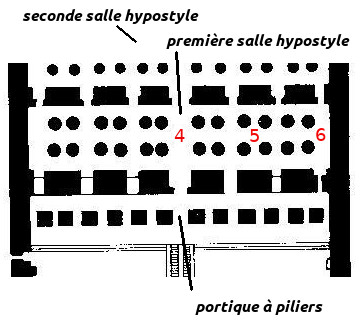
 A pillar, symbol of stability and duration; it represents Osiris' spinal column. It is also a protective amulet.
A pillar, symbol of stability and duration; it represents Osiris' spinal column. It is also a protective amulet.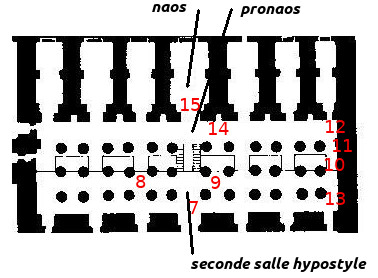
 The wife of Amon, she was venerated in Thebes. Originally depicted as a vulture, she later took on a human form.
The wife of Amon, she was venerated in Thebes. Originally depicted as a vulture, she later took on a human form. The King of the Gods is represented as a human being (at times ithyphallic), wearing a mortarboard crowned with two plumes or, at times, with a ram's head, the animal dedicated to him. With the goddess Mut and the god Khonsu, they formed the Theban Triad. He was also identified with the god Re and venerated under the name of Amon-Re. The cult's principal location was in Thebes.
The King of the Gods is represented as a human being (at times ithyphallic), wearing a mortarboard crowned with two plumes or, at times, with a ram's head, the animal dedicated to him. With the goddess Mut and the god Khonsu, they formed the Theban Triad. He was also identified with the god Re and venerated under the name of Amon-Re. The cult's principal location was in Thebes. The God of Memphis, where he was believed to have brought the universe into being; the husband of the Lion Goddess, Sekhmet, he was depicted wearing a mummy's shroud, holding in his hand the scepter. He was later likened to another Memphis god of death, Sokaris, and was worshipped in his syncretic form of Ptah-Sokaris.
The God of Memphis, where he was believed to have brought the universe into being; the husband of the Lion Goddess, Sekhmet, he was depicted wearing a mummy's shroud, holding in his hand the scepter. He was later likened to another Memphis god of death, Sokaris, and was worshipped in his syncretic form of Ptah-Sokaris.
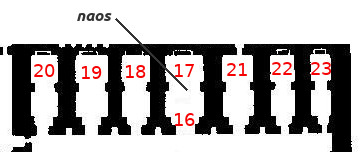
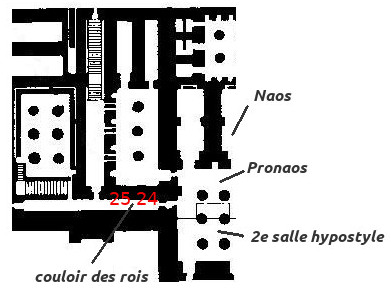
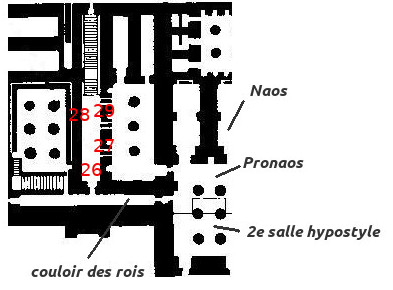

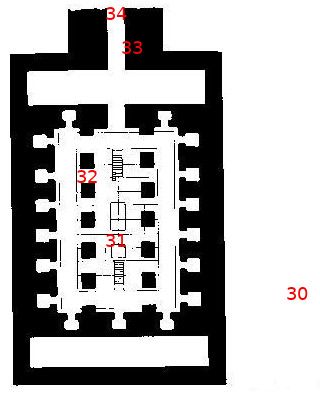
 God of the sky and protector of the pharaoh who was likened to him, Horus could either be depicted as a falcon-headed man. As the son of Osiris and Isis, he was often represented as infant (Harpocrates) with a finger held to his lips
God of the sky and protector of the pharaoh who was likened to him, Horus could either be depicted as a falcon-headed man. As the son of Osiris and Isis, he was often represented as infant (Harpocrates) with a finger held to his lips